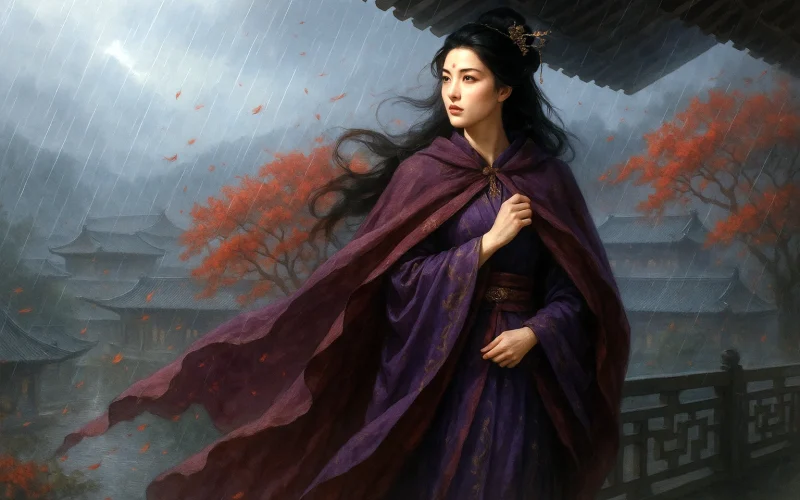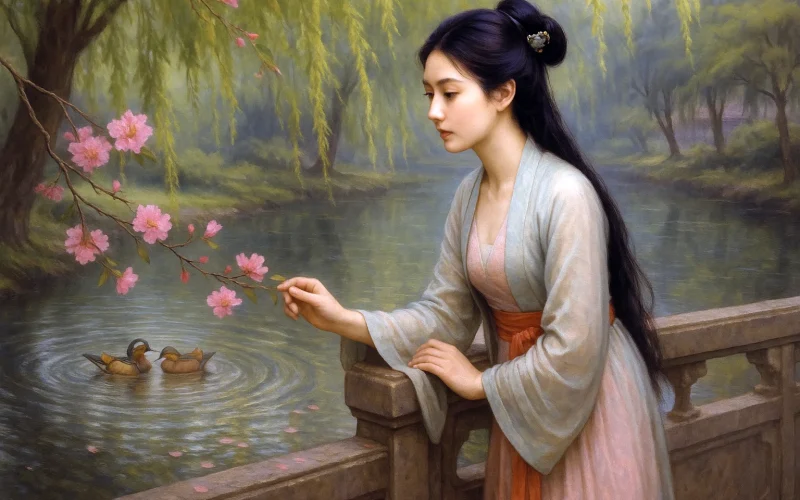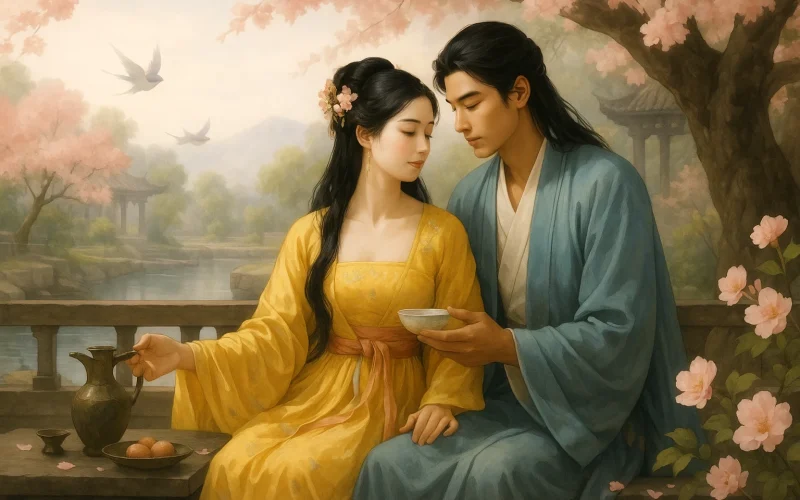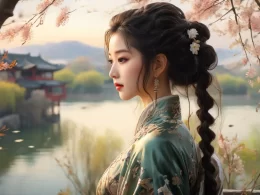How fathomless the courtyard’s glooms entwine?
Through willow-mists, layer’d drapes no eye can sum.
Where gemmed steeds paused in pleasure’s old design,
Now lofts obscure the road to wanton’s drum.
March’s fierce close with wind and rain contends,
Dusk’s bolted gates ne’er halt spring’s flying wheel.
“Answer, flowers!”—Tears meet what silence sends—
A storm of blooms past the swing’s lone appeal.
Original Poem
「鹊踏枝 · 庭院深深深几许」
冯延巳
庭院深深深几许?柳堆烟,帘幕无重数。
玉勒雕鞍游冶处,楼高不见章台路。
雨横风狂三月暮,门掩黄昏,无计留春住。
泪眼问花花不语,乱红飞过秋千去。
Interpretation
This ci poem, of uncertain authorship but traditionally ascribed to Feng Yansi (with some scholars favoring Ouyang Xiu), likely dates to a period of political disengagement—either composed during the poet's leisure or as a dramatic monologue adopting a feminine voice. It epitomizes the guī yuàn (boudoir lament) genre of the late Tang to early Song era, portraying a secluded woman's emotional turmoil as she pines for an absent lover.
First Stanza: "庭院深深深几许?柳堆烟,帘幕无重数。玉勒雕鞍游冶处,楼高不见章台路。"
Tíng yuàn shēn shēn shēn jǐ xǔ? Liǔ duī yān, lián mù wú chóng shù. Yù lè diāo ān yóu yě chù, lóu gāo bù jiàn Zhāng tái lù.
How deep, how fathomlessly deep this courtyard?
Willows heap like mist,
curtains layer upon uncounted layers.
His jade-bridled, carved-saddle steed roams pleasure haunts—
From the highest tower, I still can’t see the road to Zhangtai.
The triple repetition of "deep" (深深深) plunges the reader into the woman's claustrophobic isolation, with the courtyard's physical depth mirroring her emotional imprisonment. The "willow-mist" and "layered curtains" blur vision and psyche alike, symbolizing her obstructed connection to the outside world.
The man's "jade-bridled steed" (玉勒雕鞍) highlights his libertine escapades ("pleasure haunts" 游冶处), while "Zhangtai Road" (章台路)—a Tang-era euphemism for brothel districts—confirms his infidelity. Her futile gaze from the tower underscores her abandonment: even at her most vulnerable vantage, she cannot trace his path.
Second Stanza: "雨横风狂三月暮,门掩黄昏,无计留春住。泪眼问花花不语,乱红飞过秋千去。"
Yǔ héng fēng kuáng sān yuè mù, mén yǎn huáng hūn, wú jì liú chūn zhù. Lèi yǎn wèn huā huā bù yǔ, luàn hóng fēi guò qiū qiān qù.
Wind rages, rain slants—late March dusk.
The gate shuts on twilight;
no way to keep spring here.
Tear-blurred, I ask the flowers—they stay silent.
A riot of petals tumbles past the empty swing.
The "furious wind and slanted rain" (雨横风狂) externalize her inner torment, while "March dusk" (三月暮) marks both seasonal and romantic decay. The "shut gate" (门掩) seals her fate; "no way to keep spring" (无计留春住) laments lost youth and love with devastating economy.
The climactic "tear-blurred question" (泪眼问花) personifies nature's indifference—flowers, like her lover, refuse to answer. The "petals tumbling past the swing" (乱红飞过秋千去) crystallize her desolation: the swing, once a site of playful intimacy, now stands abandoned, as love's vibrancy scatters like petals in the storm.
Holistic Appreciation
This lyric poem, voiced through a woman's perspective, portrays the quiet anguish of boudoir confinement with exquisite subtlety and profound depth. The first stanza transitions from scene to emotion: from the "immeasurably deep courtyard" to the unreachable "Zhang Terrace Road," constructing the woman's bitter helplessness in seeing yet never meeting. The second stanza reverses this movement, letting emotion reshape the scenery—spring twilight storms and scattering blossoms mirror the protagonist's desolate isolation and fading youth. Throughout, scenery becomes emotion's perfect vessel. The courtyard's depth, willow mist's entanglement, tower's remoteness, rain's wild slanting, and blossoms' lonely fall—each reflects the woman's enclosed existence and shattered hopes. Its poignant beauty moves readers to tears.
Artistic Merits
The poem unfolds through its female protagonist's gaze, using environment, seasons and natural imagery to express profound melancholy permeating minute details. Linguistically, it employs refined subtlety—the triple "deep" (深深深) creates mesmerizing rhythm while intensifying emotional progression. Culturally rich motifs like "Zhang Terrace," "willow-woven mist," "tearful eyes questioning flowers," and "wild reds flying past" activate layered associations, deepening textual resonance. Structurally, it moves from distant to intimate, concrete to abstract, with emotions building progressively until external surroundings fully mirror the inner world.
Insights
This poem reveals how, behind latticed windows and amidst drizzling petals, a sensitive, passionate yet helpless heart burns in solitude. Beyond romantic loss, it captures women's plight under patriarchal norms and gender inequality. The poet gives voice to this silent loneliness through delicate brushwork, making readers feel the pain of spring's departure, love's fading, and human isolation. For modern audiences, its emotional resonance persists, provoking timeless meditation on companionship, fidelity and freedom.
About the Poet
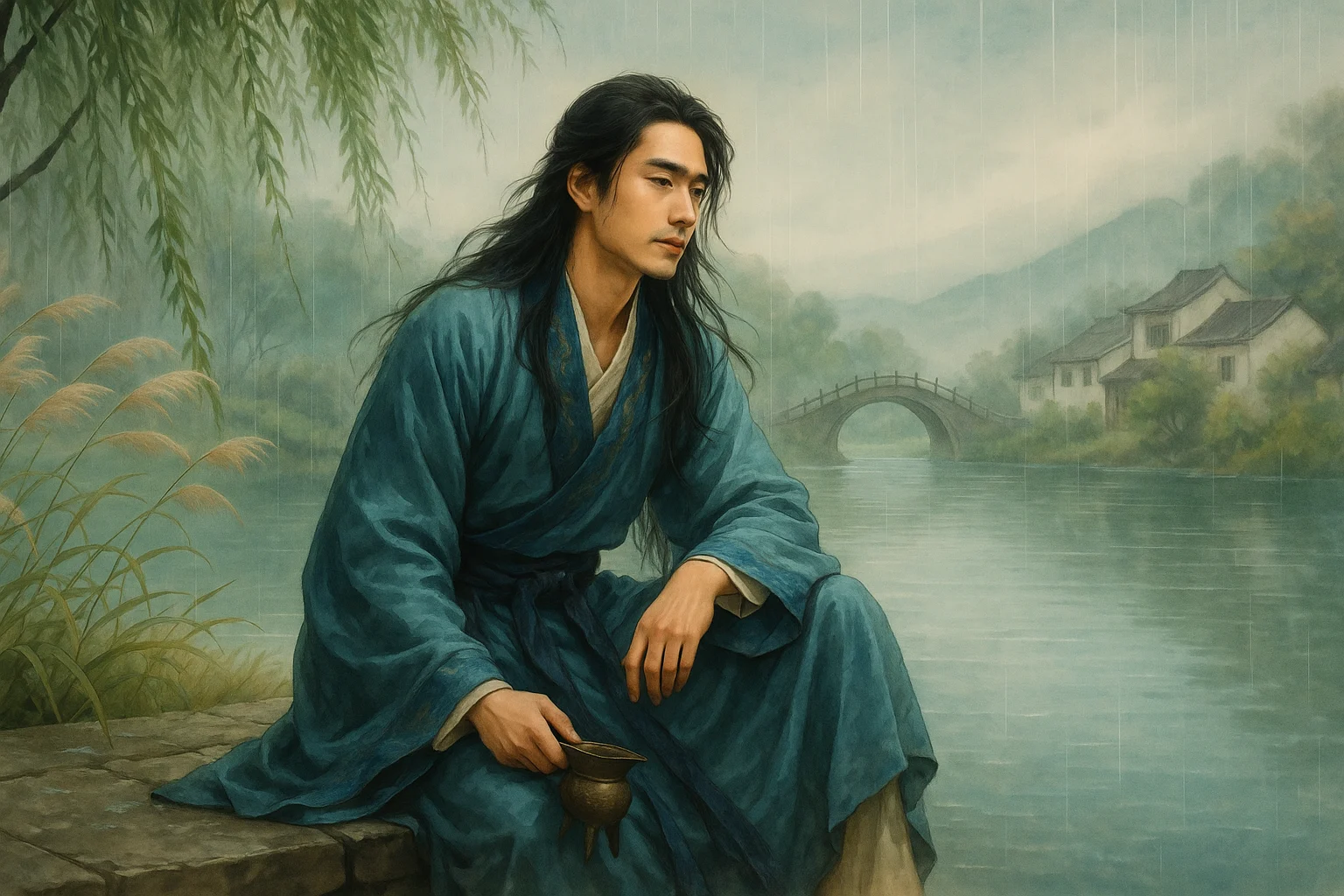
Feng Yansi (冯延巳 903 - 960), courtesy name Zhengzhong, was a native of Guangling (modern-day Yangzhou, Jiangsu) and a renowned ci poet of the Southern Tang during the Five Dynasties and Ten Kingdoms period. Rising to the position of Left Vice Director of the Department of State Affairs (Zuo Puye Tongping Zhangshi), he enjoyed the deep trust of Emperor Li Jing. His ci poetry forged a new path beyond the Huajian tradition, directly influencing later masters like Yan Shu and Ouyang Xiu, playing a pivotal role in the transition of ci from "entertainment for musicians" to "literary expression of scholar-officials."






